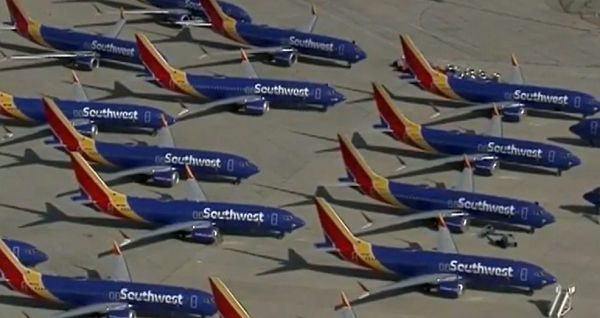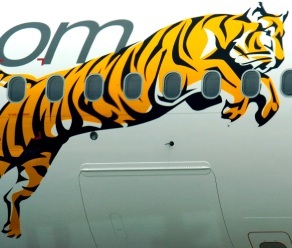Boeing didn't tell Southwest about disabled indicator
29 April, 2019
5 min read


Boeing did not tell Southwest Airlines until after the Lion Air crash that it had disabled on the Boeing 737 MAX a light designed to warn pilots an angle of attack sensor could be malfunctioning.
The angle of attack (AOA) disagree light came as standard in previous versions of the airline’s Boeing 737s and lit up, much like an engine oil warning light in a car, if two sensors in the plane were not supplying the same reading.
READ: Our 737 MAX coverage
Faulty data from angle-of-attack sensors played a role in two crashes of 737 MAX aircraft in Indonesia and Ethiopia in less than five months. The crashes, which together killed 346 people, led to the grounding of the global 737 MAX fleet.
Boeing has agreed to make the AOA indicator light standard in all MAX aircraft as part of a package of changes in response to the crashes that include changes to the controversial MCAS software and new training procedures.
The airframe manufacturer argues there are no pilot actions or procedures during flight which require knowledge of angle of attack and says flight crew instead focus on roll, pitch, altitude, heading and vertical speed.
However, it acknowledges the AOA indicator provides supplementary information and “additional context for understanding the possible cause of air speed and altitude differences between the pilot’s and first officer’s displays”.
The Wall Street Journal reported that US Federal Aviation Administration officials were also not told about the change and were worried enough to consider grounding the Southwest fleet while they considered whether its pilots required additional training. However, the discussion did not go up the FAA chain of command.
Southwest said in a statement published on CNBC: “Upon delivery (prior to the Lion Air event), the AOA disagree lights were depicted to us by Boeing as operable on all MAX aircraft, regardless of the selection of optional AOA indicators on the Primary Flight Display (PFD).
“The manual documentation presented by Boeing at Southwest’s MAX entry into service indicated the AOA Disagree Light functioned on the aircraft, similar to the lights on our NG series.
“After the Lion Air event, Boeing notified us that the AOA Disagree Lights were inoperable without the optional AOA indicators on the MAX aircraft.
“At that time, Southwest installed the AOA Indicators on the PFD, resulting in the activation of the AOA Disagree lights — both items now serve as an additional crosscheck on all MAX aircraft.”
Boeing said it did not "intentionally or otherwise deactivate the disagree alert on its MAX airplanes".
"The disagree alert was intended to be a standard, stand-alone feature on MAX airplanes,'' it said a statement. "However, the disagree alert was not operable on all airplanes because the feature was not activated as intended."
It reiterated its stance that air speed, attitude and altitude displays, together with the stick shaker, were the primary flight information indicators in the flight deck.
"All recommended pilot actions, checklists, and training are based upon these primary indicators, not on the AOA disagree alert or the angle of attack indicator,'' it said.
The planemaker said that in addition to providing the AoA disagree alert as a standard feature when the MAX returned to service, it would also give customers the option to include the AOA indicator at no costs.
"This change will be made to all MAX aircraft – production and retrofit,'' the company said.
"A new software update will separate those two features, making AOA disagree alert a standalone standard feature and keeping AOA indicator as an additional customer-selected option."
The Southwest omission comes as Boeing and the FAA face several investigations into their relationship and the certification of the 737 MAX.
The FAA has invited air safety regulators from around the world to a meeting on May 23 to discuss its plans to return the 737 MAX to service, prompting speculation the planes could be flying as early as June.
That would be quicker than many, including airlines, expected.
Boeing completed engineering certification flights for the changes in mid-April and chief executive Dennis Muilenburg said at the time he expected the next flight to be a certification flight.
However, training proposals provisionally accepted by an FAA board of experts are facing pushback from some regulators and pilots.
The board has recommended training using expanded computer-based courses while regulators from Canada and Europe have already indicated it should involve simulator training.
READ: Revised Boeing 737 MAX training "operationally suitable".
The union representing American Airlines pilots has also thrown its weight behind simulator training. It has told the FAA the current proposal would not give pilots the confidence to feel comfortable flying the plane or to relay that confidence to the traveling public.
Boeing said it developed its training and materials to be consistent with required, internationally recognized standards for pilots of passenger planes.
It noted it had also followed a process that was consistent with the introduction of previous new aircraft and derivatives.
"All 737 MAX pilots will take mandated training which familiarizes them with the MCAS function and associated airplane operational procedures,'' it said.
"In addition, Boeing has developed supplemental materials that give the pilots even greater awareness of the airplane systems’ function and performance.
"These educational materials will reinforce existing operational procedures and aircraft systems that are relevant to the safe operation of the airplane."
Ultimately, however, the manufacturer said it was up to its customers and their home country regulator to determine the best course of action for their airline and pilots.
Boeing also faces a number of lawsuits over the crashes, including from shareholders angry about the fall in the company’s share price.
Next Article
3 min read
Virgin gets nod for Tiger deal

Get the latest news and updates straight to your inbox
No spam, no hassle, no fuss, just airline news direct to you.
By joining our newsletter, you agree to our Privacy Policy
Find us on social media
Comments
No comments yet, be the first to write one.
